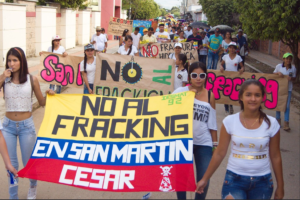China, India & Colombia’s Interbolsa
Colombian firm Interbolsa is being liquidated in a move to protect the interests of Colombia’s financial markets.
For over a decade Colombians have been debating whether or not to allow oil companies to use hydraulic fracturing, or fracking, to produce oil and gas from shale rock, a technique that has been controversial in many countries but also propelled the United States to the world’s top crude producer. The high court’s decision last week to uphold a moratorium on fracking suggests the increasingly polarized debate is far from over.
Colombia has flip-flopped on fracking for many years. The basic regulatory framework was created in 2008 and has since been updated to reflect new practices and regulations internationally as well as local studies. A two year study was undertaken in 2014 to understand the environmental impacts of shale development and incorporate them into regulations. Yet in 2018, Colombia’s high court provisionally suspended the previous rules used to regulate fracking, citing concerns over its effect on the environment and human health, and since then its legal status has been in limbo.
Colombia’s conservative president Ivan Duque was ambivalent in his position on shale development during his electoral campaign. Facing the leftist candidate Gustavo Petro, who opposed all forms of fossil fuel production in the country, Duque sought to strike a balance by taking the stance that fracking could be done safely with sufficient monitoring.
But upon taking office he seemed determined to resolve the question of environmental impacts and advance with shale development, driven by concerns over depleting oil reserves. According to Colombia’s National Hydrocarbon Agency, the country’s oil reserves will only last until 2024 at current production rates. Exploiting Colombia’s shale potential could almost triple the country’s oil and gas reserves, energy minister Maria Fernanda Suarez noted recently. In December 2018, Duque appointed a 13-member committee tasked with analyzing the methods and risks of fracking using existing data. The group recommended starting with three pilot projects under strict monitoring standards.
However, this committee was later criticized by Alianza Colombia Libre de Fracking, an umbrella organization of roughly 40 environmental groups. The organization claimed that the first panel had too many conflicts of interest, including previous employment at major oil companies and openly expressed pro-fracking stances. The high court stepped back into the fray, appointing a new committee in June composed of an interdisciplinary group of members from the left-leaning National University in Bogota, to again reevaluate the environmental impacts of fracking. Not surprisingly, the new committee came to a conclusion that aligned with the high court’s 2018 decision — that Colombia lacks sufficient information to decide whether to allow fracking. This decision led the high court to reinstate the moratorium on fracking. A few days later the court clarified that the moratorium did not prohibit the pilot projects from going forward.

Meanwhile, the Duque government’s efforts to move forward with shale development also face opposition from some local communities. For example, San Martin, a town of 25,000 people, has drawn press over its resistance to pilot projects. Located in the shale-rich province of Cesar, San Martin’s residents believe fracking could deplete their water reserves. Several bills have also been proposed in Congress to ban fracking. In addition, a lawyer, with support from the Universidad del Norte, anti-fracking activists and a leftist lawmaker, filed a suit against the energy ministry to halt potential use of the technique.
In reality, there is an abundance of information about the impacts of fracking, both from the studies carried out in Colombia and from the United States’ experience in producing oil and gas from shale rock, which spans almost 20 years. The US experience has demonstrated that the risks associated with fracking can be largely mitigated and are no greater than the risks from conventional drilling, assuming best practices are employed. For example, proper well casings can avoid the risk of contamination of the water supply. Most of the water used in hydraulic fracturing can be recycled. And today’s technologies can control the release of methane.
The controversy over fracking in Colombia is ultimately a political rather than technical discussion. Both those in favor and those opposed to fracking are using the same information and coming to opposite conclusions. No matter how many times the information is reviewed by experts, it seems that neither side will change their position. If President Duque truly wants to introduce fracking, he must convince the public that there is ample information available to understand how to mitigate the risks of fracking and that the next step is to test those techniques in the pilot projects—and then revise regulations as necessary based on information collected from practical experience. If he fails to do so, Colombia will continue on its path toward becoming a net oil importer, while the country persists with its endless debate.
Shale Development & the Environment: Policy Lessons for Latin America
Extractive Industries and Environmental Regulation in Post-Conflict Colombia
President Ivan Duque Marquez: Colombia’s Domestic and Regional Opportunities and Challenges
Colombian firm Interbolsa is being liquidated in a move to protect the interests of Colombia’s financial markets.
China has became a critical economic partner for Venezuela over the past decade.
Chinese lending to Latin America and the Caribbean hit an all-time high of $37 billion in 2010.